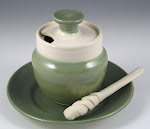I have had a teacher the last few months. I haven’t met him in person, but in this day of video proliferation, I found him on YouTube. He has nearly 500 videos up there, on all different aspects of making pottery. He’s a good teacher, too. I’ve gleaned some fresh understanding that invigorates and improves some of my old practices. As a result, the work has made a small leap forward lately.
http://www.youtube.com/user/sleachpots
That’s Simon Leach.
Simon’s grandfather Bernard Leach (1887-1979) was sometimes called the “father of British studio pottery.” An artist by inclination, he studied in Japan and then opened a pottery in Cornwall, England in 1920 with a great Japanese potter, Shoji Hamada. Bernard's teaching history was long and influential. It tapped into a most fundamental idea of Japanese pottery, beautiful function. His sons David and Michael were potters in similar style. Bernard’s grandson, David’s son, is my newfound pottery video teacher, Simon. He finds his own way in the aesthetic of his grandfather. He works within the tradition, although his voice is his own.
Why do I tell you all this? Because it blows me away. What can it be like to have a tradition of pottery-making to tap into? To have the skills and aesthetics laid out for you to learn and absorb from an early age? To understand that beauty in a functional object can be a given? I wonder because I have no such tradition, and must find my way as if everything is a new discovery.
What is it that make Judaism and clay a difficult team to yoke together?
From archaeological digs in Israel, you find clay objects of old Judea: olive oil jars and other storage jars, and oil lamps. Matter from the earth was used to make the most basic utilitarian ware. Since idols were out for us monotheists, you don’t really find figures.
On my trips to modern Israel, I see jewelry and pottery, sculpture in all media, all around. Even a flower arrangement is so much more creative there than here in the U.S. There is a bright, inventive spirit among the people, who came from all over the world to settle there and brought a spirit of adventure and freedom of expression. More creative thinking didn’t just arise from the kibbutz movement that originally tried to jettison religion in favor of a new social order. It’s way more than that. Autonomy has led somehow to great creativity. Color, texture and free form are everywhere. Maybe it’s the neutral colors of pale stone and blue sky that encourage art to sprout- the same effect as the white walls of a museum, where art is shown to its best advantage. Playgrounds can be found made of altered and brightly painted old farm equipment. Playground slides are turned into fanciful creatures. What freshness! Why? These are Jews, too. Why do they have a more creative art outlook than the wonderful people among whom I grew up?
Originally a kid from the sticks with many siblings and little money, my strongest early influences are extremely utilitarian. Necessity dictates. Even now, as a person who is not counting pennies every day to get by as my parents had to, my frugal sensibility remains. What is more, it is common to many: at a recent local show, in typical fashion, I sold none of the covered jars with curly-whirly handles and lid knobs (they have no obvious purpose, being too silly-looking to hold flour), but sold a lot of the trays that read “Challah” and other items of Judaic use. Function. It justifies expenditures.
Maybe I'm lucky to have no family or cultural tradition for what I do. Maybe it frees me to surf around and choose the most appealing bits from world art and use them, like spice in cuisine, to flavor my work. I even take and channel these bits into items of Judaica.
That’s my challenge. Make it utilitarian- and have it satisfy on some level as art.
Subscribe to:
Post Comments (Atom)

No comments:
Post a Comment